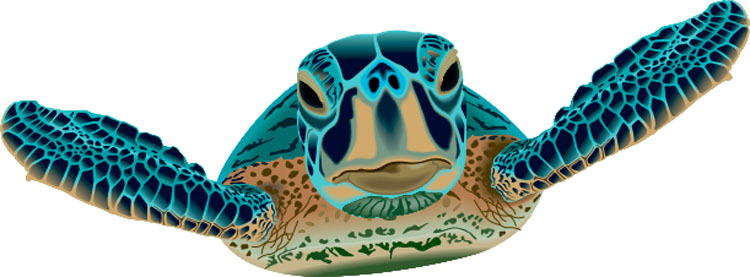The 2024 Turtle Nesting Season Is Here
May 20, 2024 at 4:34 p.m.

CWC volunteers stand in a hole that beachgoers didn’t fill in, creating a dangerous situation for both turtles and humans. (l-r): Marylin Byrd, Pauline Logsdon, Sylas Foglio and Kristin Foglio.
The 2024 sea turtle nesting season has begun and every day, new cordoned off yellow-tape areas marking a nest appear along the shoreline. Coastal Wildlife Club’s Sea Turtle Patrol volunteers actually began walking the beaches of Manasota Key and a small section of Knight Island on April 15th to look for early nesting activities prior to the “official” season, May 1st through October 31st. These dedicated volunteers will walk every morning at first light to look for evidence of female sea turtles crawling ashore to lay their cache of eggs in a nest along the shoreline. They document every nest with extensive data and monitor the site until the hatchlings emerge; this information is relayed to the Florida Wildlife Research Institute of the Florida Fish and Wildlife Conservation Commission.
There are three sea turtle species that call Florida home. The most common one is Loggerhead (Caretta caretta), followed by the threatened Green (Chelonia mydas) and most rarely the critically endangered Kemp’s ridley (Lepidochelys kempii). All three species are categorized as endangered or critically endangered. Beachgoers and residents as well as visitors living along the Gulf are asked to help give these sea turtles the best odds possible for successful nesting.
Did you know that only one in 1,000 hatchlings survive to achieve adulthood? Not only do they face challenges in nest (predators seeking eggs), the trek to the water’s edge is fraught with danger from birds, ghost crabs and becoming stuck or entangled in holes, seaweed and beach gear left in their way. Once in the water, they must swim out approximately two miles to begin feeding on sea grasses, running a gauntlet of eagle-eyed birds and fish. These little hatchlings need everyone’s help to survive and flourish. If successful, the females will return to the area in 25-30 years when they reach maturity! Boaters need to be alert for adult turtles mating and swimming near shore.
Here’s how everyone can help sea turtles survive and thrive:
• Sea turtles, adults and hatchlings, need dark beaches. They use the natural light of the horizon over the Gulf to find their way safely to the water. Be vigilant: Are the lights at your property located on or near the beach turned off at night or well shielded? If you do need outdoor lighting, the Florida Wildlife Commission states that fixtures must be mounted as low as possible with the lowest wattage necessary for the needed purpose. Bulbs must produce only long wavelength light which is amber, orange or red. The fixture must be completely downward directed and must shield the bulb from the beach. Also, remember to close your curtains at sunset to block light from reaching the beach. Learn more about myfwc.com.
• Sea turtles need flat beaches without holes. Sure, it’s lots of fun for kids (and adults) to dig large holes to build fortresses with moats or swimming holes but please take a moment to fill them in when you are ready to leave. Even flattening or caving in your hole is fun. Large holes are hazardous to adult turtles, hatchlings and to people. Turtles can become trapped in a big hole and humans can stumble and fall. Be vigilant: Fill in holes you make or abandoned holes that you encounter. Even a small hole can be a lethal trap for a two-inch hatchling, exposing it to predators such as birds and ghost crabs.
• Sea turtles, large and small, need beaches free of obstructions. When you leave the beach for the day, remove all your stuff. Gently remind your neighbors to do the same. Canopies, kayaks, volleyball nets, toys, fishing line, trash, and beach furniture may stress turtles, slow their progress, or entangle them potentially with lethal results. Sea turtles coming ashore to nest during the night may become trapped or tangled up in webbed chairs, toys, tents and other items left overnight.
 Image Caption
Image Caption
• Many people enjoy walking on the beach or fishing at night. Use the moon or natural starlight to illuminate your way. Flashlights or cellphone lights are bright enough to distract and disorient an adult turtle or hatchling. A red flashlight used for personal safety should be turned on minimally, held in one hand and shielded with the other. For those fishing at night, shield your light so it only lights where you are and isn’t a distracting beacon.
For those enjoying the beach during daylight hours, you may, if you are lucky, see an adult turtle coming ashore to nest. While you watch from a respectable distance, take photos and report the crawl by calling or texting 941-212-2214. The rare, endangered Kemp’s ridley turtle typically nests during the day and sea turtle patrol volunteers need to know of the sighting and respond to document the crawl and hopefully, a nest. You are indeed privileged if you are lucky enough to witness this but please stay back at least 50 feet and allow the female to complete her mission.
If you come across a turtle or hatchling in distress or deceased, please report it ASAP to the Florida Wildlife Commission at 888-404-3922. Learn more about sea turtle nesting season in Florida by visiting coastalwildlifeclub.org or myfwc.com.